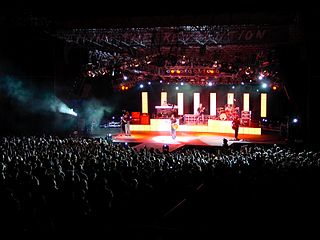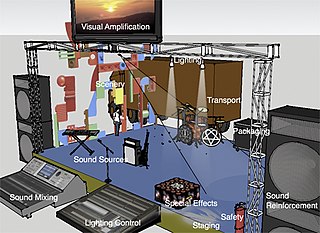Related Research Articles

A subwoofer is a loudspeaker designed to reproduce low-pitched audio frequencies known as bass and sub-bass, lower in frequency than those which can be (optimally) generated by a woofer. The typical frequency range for a subwoofer is about 20–200 Hz for consumer products, below 100 Hz for professional live sound, and below 80 Hz in THX-certified systems. Subwoofers are never used alone, as they are intended to augment the low-frequency range of loudspeakers that cover the higher frequency bands. While the term "subwoofer" technically only refers to the speaker driver, in common parlance, the term often refers to a subwoofer driver mounted in a speaker enclosure (cabinet), often with a built-in amplifier.

A loudspeaker is an electroacoustic transducer; a device which converts an electrical audio signal into a corresponding sound. The most widely used type of speaker is the dynamic speaker. The sound source must be amplified or strengthened with an audio power amplifier before the signal is sent to the speaker.

A public address system is an electronic system comprising microphones, amplifiers, loudspeakers, and related equipment. It increases the apparent volume (loudness) of a human voice, musical instrument, or other acoustic sound source or recorded sound or music. PA systems are used in any public venue that requires that an announcer, performer, etc. be sufficiently audible at a distance or over a large area. Typical applications include sports stadiums, public transportation vehicles and facilities, and live or recorded music venues and events. A PA system may include multiple microphones or other sound sources, a mixing console to combine and modify multiple sources, and multiple amplifiers and loudspeakers for louder volume or wider distribution.

A sound reinforcement system is the combination of microphones, signal processors, amplifiers, and loudspeakers in enclosures all controlled by a mixing console that makes live or pre-recorded sounds louder and may also distribute those sounds to a larger or more distant audience. In many situations, a sound reinforcement system is also used to enhance or alter the sound of the sources on the stage, typically by using electronic effects, such as reverb, as opposed to simply amplifying the sources unaltered.

A horn loudspeaker is a loudspeaker or loudspeaker element which uses an acoustic horn to increase the overall efficiency of the driving element(s). A common form (right) consists of a compression driver which produces sound waves with a small metal diaphragm vibrated by an electromagnet, attached to a horn, a flaring duct to conduct the sound waves to the open air. Another type is a woofer driver mounted in a loudspeaker enclosure which is divided by internal partitions to form a zigzag flaring duct which functions as a horn; this type is called a folded horn speaker. The horn serves to improve the coupling efficiency between the speaker driver and the air. The horn can be thought of as an "acoustic transformer" that provides impedance matching between the relatively dense diaphragm material and the less-dense air. The result is greater acoustic output power from a given driver.
Klipsch Audio Technologies is an American loudspeaker company based in Indianapolis, Indiana. Founded in Hope, Arkansas, in 1946 as 'Klipsch and Associates' by Paul W. Klipsch, the company produces loudspeaker drivers and enclosures, as well as complete loudspeakers for high end, high fidelity sound systems, public address applications, and personal computers.

Altec Lansing, Inc. is a U.S. audio electronics company founded in 1927. Their primary products are loudspeakers and associated audio electronics for professional, home, automotive and multimedia applications.
Electro-Voice (EV) is an American manufacturer of audio equipment, including microphones, amplifiers, and loudspeakers, focused on pro audio applications such as sound reinforcement. As a subdivision of Telex Communications Inc. since February 1998, Electro-Voice markets products for use by consumers as well as small or large concert venues, broadcasting, houses of worship, and in retail situations.
Eastern Acoustic Works (EAW) is an American manufacturer of mainly professional audio reinforcement tools, such as loudspeaker systems and processors. From 1978-1988 it was located at 59 Fountain Street in Framingham, Massachusetts, and subsequently One Main Street in Whitinsville, Massachusetts.

Acoustic Research was a Cambridge, Massachusetts-based company that manufactured high-end audio equipment. The brand is now owned by VOXX. Acoustic Research was well known for the AR-3 series of speaker systems, which used the 12-inch (305 mm) acoustic suspension woofer of the AR-1 with newly designed dome mid-range speaker and high-frequency drivers, which were the first of their kind. AR's line of acoustic suspension speakers was extraordinary for its time, as they were the first loudspeakers with flat response, extended bass, wide dispersion, small size, and reasonable cost.
Meyer Sound Laboratories is an American company based in Berkeley, California that manufactures self-powered loudspeakers, multichannel audio show control systems, electroacoustic architecture, and audio analysis tools for the professional sound reinforcement, fixed installation, and sound recording industries.
LARES is an electronic sound enhancement system that uses microprocessors to control multiple loudspeakers and microphones placed around a performance space for the purpose of providing active acoustic treatment. LARES was invented in Massachusetts in 1988, by engineers working at Lexicon, Inc.

John Meyer is a pioneer in the sound reinforcement industry. In 1979 he founded Meyer Sound Laboratories with his wife, Helen Meyer.

Live event support includes staging, scenery, mechanicals, sound, lighting, video, special effects, transport, packaging, communications, costume and makeup for live performance events including theater, music, dance, and opera. They all share the same goal: to convince live audience members that there is no better place that they could be at the moment. This is achieved through establishing a bond between performer and audience. Live performance events tend to use visual scenery, lighting, costume amplification and a shorter history of visual projection and sound amplification reinforcement.
A coaxial loudspeaker is a loudspeaker system in which the individual driver units radiate sound from the same point or axis. Two general types exist: one is a compact design using two or three speaker drivers, usually in car audio, and the other is a two-way high-power design for professional audio, also known as single-source or dual-concentric loudspeakers.

David W. Gunness is an American audio engineer, electrical engineer and inventor. He is known for his work on loudspeaker design, especially high-output professional horn loudspeakers for public address, studio, theater, nightclub, concert and touring uses.

Cliff Henricksen is a musician, inventor and audio technologist. He is self-taught as a musician with a graduate degree in mechanical engineering at Massachusetts Institute of Technology (MIT). Throughout his career Cliff has found innovative ways to apply engineering basics to electro acoustics and to audio technology as it applies to music and in particular to live music performance. He has invented and engineered a wide variety of technologies and products well known in the world of professional audio. Today he balances work in audio and work as a performing musician.

In a loudspeaker, a phase plug, phasing plug or acoustical transformer is a mechanical interface between a speaker driver and the audience. The phase plug extends high frequency response because it guides waves outward toward the listener rather than allowing them to interact destructively near the driver.

Charles Emory Hughes II is an American inventor and audio engineer. He is known for his work on loudspeaker design, and the measurement of professional audio sound systems. Hughes first worked for Peavey Electronics designing loudspeakers and horns where he was granted a patent for the Quadratic-Throat Waveguide horn used in concert loudspeakers. He worked for Altec Lansing for two years as chief engineer for the pro audio division and was granted two more patents. In 2021, Hughes was hired by Biamp as principal engineer.
Thomas J. Danley is an American audio engineer, electrical engineer and inventor, the holder of multiple patents for audio transducers, especially high-linearity, high-output professional horn loudspeaker systems. Danley first gained notice in the 1980s with his novel servomotor-driven subwoofer systems used to reproduce very low frequencies in concert tours and theme parks. In 2000 he advanced the implementation of multiple-entry horns in 2000 with several designs led by the SPL-td1, a seven-driver loudspeaker. In 2005, he started a new company, Danley Sound Labs, through which he patented further technologies and produced a wide variety of loudspeaker models based on these technologies.
References
- 1 2 3 4 "About Community". Community Professional Loudspeakers website. Archived from the original on 18 March 2013. Retrieved 8 August 2012.CS1 maint: discouraged parameter (link)
- ↑ Gustafson, Alice (October 6, 2015). "Audioprof Group International Acquires Majority Share in Community Professional Loudspeakers". Essential Install. Retrieved May 12, 2021.
- ↑ Staff (July 11, 2019). "Biamp Acquires Community Loudspeakers and Apart Audio". ProSound News. Retrieved May 12, 2021.
- ↑ "Management Perspectives" (PDF). Entertainment Technology Asia. Archived from the original (PDF) on 17 March 2013. Retrieved 30 November 2012.CS1 maint: discouraged parameter (link)
- 1 2 3 "Community Spirit". Pro Audio Asia (May–June): 134–137. May–June 2008. Archived from the original on 2010-06-13. Retrieved 2012-08-08.
- 1 2 "Employment and HR". Community Professional Loudspeakers website. Archived from the original on 22 July 2013. Retrieved 8 August 2012.CS1 maint: discouraged parameter (link)
- ↑ "Patent Granted for Community Technology". The AES Daily (Friday): 18. 4–7 November 2010.
- ↑ Baker, Paddy. "Streets flooded. Please advise". Installation Europe. Archived from the original on 31 October 2012. Retrieved 30 November 2012.CS1 maint: discouraged parameter (link)